| Name | Year | Formation | Location | Notes | Images |
|---|
| Alwalkeria | 1994 | Lower Maleri Formation (Late Triassic, Carnian) |  India India | Possessed different types of teeth in its upper jaw |  |
| Archaeodontosaurus | 2005 | Isalo III Formation (Middle Jurassic, Bajocian to Bathonian) |  Madagascar Madagascar | Retained "prosauropod"-like teeth despite its late age |  |
| Barapasaurus | 1975 | Kota Formation (Early Jurassic, Sinemurian to Pliensbachian) |  India India | Several individuals have been found associated with tree trunks, which may represent the aftermath of a flood [1] | 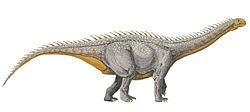 |
| Brachypodosaurus | 1934 | Lameta Formation (Late Cretaceous, Maastrichtian) |  India India | Has been suggested to be a thyreophoran, but such an identification is unlikely | |
| Bruhathkayosaurus | 1987 | Kallamedu Formation (Late Cretaceous, Maastrichtian) |  India India | Reportedly exceptionally large but its fossils have been lost. [2] Its bones have been informally speculated to be misidentified tree trunks [3] [4] [5] but later research suggests at least the tibia is real [6] | 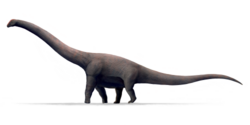 |
| Coeluroides | 1933 | Lameta Formation (Late Cretaceous, Maastrichtian) |  India India | Potentially synonymous with Ornithomimoides [7] |  |
| Compsosuchus | 1933 | Lameta Formation (Late Cretaceous, Maastrichtian) |  India India | Has been suggested to be both an abelisaurid [8] and a noasaurid [9] |  |
| Dahalokely | 2013 | Ambolafotsy Formation (Late Cretaceous, Turonian) |  Madagascar Madagascar | Shares features of both abelisaurids and noasaurids |  |
| Dandakosaurus | 1982 | Kota Formation (Early Jurassic, Pliensbachian to Toarcian) |  India India | Poorly known but large for an early theropod |  |
| Dryptosauroides | 1932 | Lameta Formation (Late Cretaceous, Maastrichtian) |  India India | Only known from six caudal vertebrae |  |
| Indosaurus | 1933 | Lameta Formation (Late Cretaceous, Maastrichtian) |  India India | Had a characteristically thickened skull |  |
| Indosuchus | 1933 | Lameta Formation (Late Cretaceous, Maastrichtian) |  India India | Its skull was flattened and topped by a short crest |  |
| Isisaurus | 2003 | Lameta Formation (Late Cretaceous, Maastrichtian) |  India India | Unusually proportioned with a short, robust neck and long limbs |  |
| Jainosaurus | 1995 | Lameta Formation (Late Cretaceous, Maastrichtian) |  India India | Originally named as a species of Antarctosaurus | 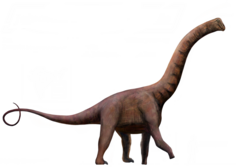 |
| Jaklapallisaurus | 2011 | Upper Maleri Formation (Late Triassic, Norian to Rhaetian) |  India India | May have been closely related to South American sauropodomorphs [10] | |
| Kotasaurus | 1988 | Kota Formation (Early Jurassic, Sinemurian to Pliensbachian) |  India India | The neural spines of its vertebrae were massively constructed, which is a basal trait |  |
| Laevisuchus | 1933 | Lameta Formation (Late Cretaceous, Maastrichtian) |  India India | Only known from three vertebrae but can confidently be assigned to the Noasauridae [11] | 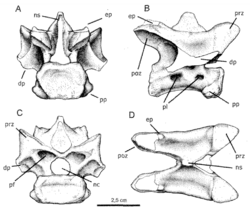 |
| Lametasaurus | 1923 | Lameta Formation (Late Cretaceous, Maastrichtian) |  India India | Described based on now lost remains, it is currently seen as a possible chimera including theropod material and osteoderms of uncertain origin |  |
| Lamplughsaura | 2007 | Upper Dharmaram Formation (Early Jurassic, Sinemurian) |  India India | Large and robustly built |  |
| Lapparentosaurus | 1986 | Isalo III Formation (Middle Jurassic, Bathonian) |  Madagascar Madagascar | Relatively fast-growing as evidenced by the preservation of a large amount of fibrolamellar bone [12] |  |
| Majungasaurus | 1955 | Maevarano Formation (Late Cretaceous, Maastrichtian) |  Madagascar Madagascar | Bite marks on several specimens have been found to perfectly match the teeth of this genus, suggesting cannibalistic tendencies [13] |  |
| Maleriraptor | 2025 | Upper Maleri Formation (Late Triassic, Norian) |  India India | This genus fills a temporal gap between older South American herrerasaurs and younger North American taxa [14] |  |
| Masiakasaurus | 2001 | Maevarano Formation (Late Cretaceous, Maastrichtian) |  Madagascar Madagascar | Possessed procumbent teeth at the tips of its jaws which may indicate a feeding specialization |  |
| Nambalia | 2011 | Upper Maleri Formation (Late Triassic, Norian to Rhaetian) |  India India | Known from the remains of two individuals | |
| Narindasaurus | 2020 | Isalo III Formation (Middle Jurassic, Bathonian to Callovian) |  Madagascar Madagascar | The oldest known turiasaur |  |
| Ornithomimoides | 1932 | Lameta Formation (Late Cretaceous, Maastrichtian) |  India India | Two species have been named, both from isolated vertebrae | 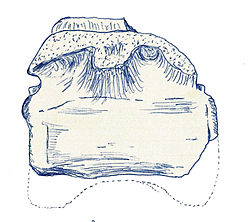 |
| Orthogoniosaurus | 1931 | Lameta Formation (Late Cretaceous, Maastrichtian) |  India India | Only known from a single, fragmentary tooth | |
| Pradhania | 2007 | Upper Dharmaram Formation (Early Jurassic, Sinemurian) |  India India | Closely related to Massospondylus [15] |  |
| Rahiolisaurus | 2010 | Lameta Formation (Late Cretaceous, Maastrichtian) |  India India | Remains of multiple growth stages are known |  |
| Rajasaurus | 2003 | Lameta Formation (Late Cretaceous, Maastrichtian) |  India India | Possessed a single, short horn on its forehead that may have been used for display and head-butting [16] |  |
| Rapetosaurus | 2001 | Maevarano Formation (Late Cretaceous, Maastrichtian) |  Madagascar Madagascar | Known from almost the entire skeleton, including the skull |  |
| Tharosaurus | 2023 | Jaisalmer Formation (Middle Jurassic, Bathonian) |  India India | The oldest dicraeosaurid, diplodocoid and neosauropod currently known |  |
| Titanosaurus | 1877 | Kallakurichi Formation, Lameta Formation (Late Cretaceous, Maastrichtian) |  India India | Although only known from a few bones, this genus is the namesake of the Titanosauria and the Titanosauriformes |  |
| Vahiny | 2014 | Maevarano Formation (Late Cretaceous, Maastrichtian) |  Madagascar Madagascar | May have been a rare component of its habitat due to the paucity of its remains | |

































